BY MARGY ROCHLIN
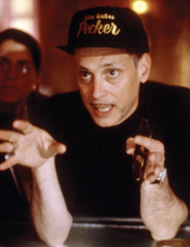 TRUE LOVE: John Waters gleefully
TRUE LOVE: John Waters gleefully
admits he got lots of things from the
film, even his trademark pencil mustache.
John Waters can remember the first time he saw Frank Tashlin's
The Girl Can't Help It, the gloriously crazy sendup of rock 'n' roll, Marilyn Monroe, and the show biz fame-making machine. When Waters entered Baltimore's Towson movie theater in 1956, he was a skinny 10-year-old pop culture nut excited to see performances by idols like Little Richard and Gene Vincent. Ninety minutes or so later, he'd fallen under a cinematic spell. "This wasn't a movie that my boy classmates wanted to see or cared about," recalls Waters, now 63, sitting cross-legged on his bed, the only room in his San Francisco apartment that has a DVD player. "They weren't interested in discussing Jayne Mansfield's complete lack of roots. I really had no one that I could be enthusiastic with about it. So it was a private secret of mine, this movie."
At least until he found a partner in crime in his outsized childhood neighbor, Harris Glen Milstead, who dressed in drag and went by the name of Divine. In Milstead, he also found the star of many of his films, his own Jayne Mansfield. ("Well, Jayne Mansfield mixed with Godzilla," Waters remarks dryly.)
"It wasn't an event, it was a requirement [to see the movie]," says Waters, of why he and his longtime crew all seem so influenced by The Girl Can't Help It. In fact, it's almost as if bits of it are scattered throughout the films of his beguilingly strange oeuvre that began in 1964 when his grandmother presented him with an 8 mm Brownie movie camera and he made his first film, a 17-minute short about interracial romance called Hag in a Black Leather Jacket.
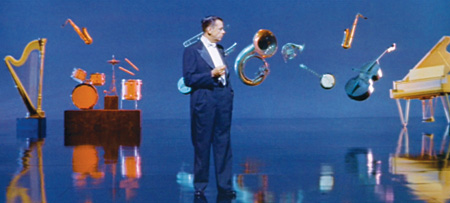 Tom Ewell snaps his fingers and the film suddenly becomes a world of brilliantly hued, fake color.
Tom Ewell snaps his fingers and the film suddenly becomes a world of brilliantly hued, fake color.
"I totally stole this!" Waters exclaims only seconds into the opening sequence of the film. In it, a tuxedoed Tom Ewell, filmed in black and white, faces the camera and formally explains that the movie was shot in CinemaScope. Ewell waves his fingers to the left, then the right and the panels of the movie open up and the constricted screen blossoms to CinemaScope width. "In the beginning of Polyester, I say, 'Ladies and gentlemen, this is Odorama,' but the joke is that screen only gets about 1/50 wider." Before the actual narrative kicks into gear, Ewell adds that the film was shot in "gorgeous, lifelike color by De Luxe," and after a finger snap, the movie suddenly becomes brilliantly hued. "Ooooh," says Waters, marveling over the lush blue, purple and orange jewel tones. "If only my bedroom looked like that. If only the world looked like that! I wanted to live my real life in that kind of over-the-top color. It's so... it's so... it's so... fake!"
But the real narrative of the movie still hasn't even kicked in yet. Ewell now attempts to synopsize the movie's feathery plot—it's the story of a small-time, down on his luck press agent (Ewell) who is hired by a churlish gangster (Edmond O' Brien) to turn his kewpie doll girlfriend (Jayne Mansfield) into a singing sensation. But, midway through, he's drowned out by the sound of Little Richard belting out "The Girl Can't Help It" from a nearby jukebox. "This song always made me insane," says Waters. "I played it the first time you see Divine in Pink Flamingos, going down the steps in Baltimore. Later in life, whenever Divine would come onstage, they'd play this. It became his theme song—in a hippie, lunatic joke way."
The opening credits roll and Ewell is replaced by young couples jitterbugging on a highly polished dance floor. Waters realizes that Lori Eastside, the choreographer of his 1990 star-crossed lovers "musical" Cry-Baby, has lifted some of these dance routines. "Some of these steps are exactly the same! See? Everyone who has ever worked on my movies has been influenced by this movie."

VA VA VOOM: Ewell takes Jayne Mansfield to a nightclub to showcase her talents. Waters
says he always preferred Mansfield to Marilyn Monroe. "I always like whoever was called
second-rate more, because they're more extreme."
We finally get to see Ewell as Tom, the seedy agent boozing it up at a nightclub when he is summoned to the Park Avenue apartment of mobster, Fats Murdock (O'Brien). "Stop talking," Waters barks at the screen during a stretch where Fats and Tom get acquainted. "It's so slow. This is just pages of dialogue. The rule of thumb is a minute a page—this is like 10 minutes a page. At any test screening today they'd say, 'Speed it up here,' and they'd be right." But Waters perks up as soon as Mansfield finally makes her astonishing dame-in-the-doorway entrance. "Look at that waist! Is that a drag queen or what?" Waters says of Mansfield's exaggerated hourglass figure squeezed into a skintight white silk gown. "I always liked her better than Marilyn Monroe. I always like whoever was called second-rate more, because they're more extreme. Mansfield had a bar in her house open at all times to the press. Like, you could just go to her house and she'd come in in a bikini and make you a cocktail. It wasn't like a press agent set it up. She just had a place for spontaneous press conferences for no reason."
Back at Tom's nightclub hangout, an unmoving camera gazes at a nameless combo singing rock 'n' roll. "It's all master shots," says Waters, focusing on the stationary quality of many of the film's musical sequences. "There's no over the shoulder, any of that. When you look at a lot of old movies they don't have coverage—like how I cut Pink Flamingos. But that was because it was single system sound right on the film so you couldn't overlap the sound. I just had to shoot long takes like a play. This movie is almost like a play, too. There's almost no cuts. The only person that I can think who really does that well is Woody Allen. Nobody does a medium long shot like Woody."
 SPELLBOUND: The film uses three famous sight gags as
SPELLBOUND: The film uses three famous sight gags as
Mansfield walks down the street.
What follows next are three famous sight gags: As Jerri minces up the street to Tom's apartment, the hot lust she inspires melts huge blocks of ice in a worker's hands; milk froths out of a milkman's bottles; and a neighbor's eyeglasses shatter. "Divine and I went crazy over these," says Waters, who paid tribute to one of the bits in Female Trouble by casting a gentleman with a trick glass eye. "His eyeball would pop out when Divine walked by." Next Jerri lets herself into the apartment of a very hungover Tom and Waters' attention is diverted by the fastidiously color-coordinated set. "This hardly looks like a bachelor pad," he says, taking in Tom's tastefully arranged armchairs, throw pillows and creamy-toned wallpaper. "Everything matches! It looks like a teenage girl lives there."
To Waters one of the most thrilling aspects of the movie is the total disinterest in representing life as it really is. "It's the opposite of an independent film. There's almost no locations in this movie—it's all sets and there's no reality. It's certainly not Dogma 95," he waxes while, as if to prove his point, Jerri hovers over a frying pan cooking Tom a restorative breakfast wearing a sexy dress with a plunging neckline. "The bacon grease would splatter on your cleavage. Ow!"
The action shifts to a nightclub later that evening and the camera pans up from a pair of shiny two-toned shoes to reveal Little Richard at the piano, raspily belting out a tune and glaring upwards at something, although it's unclear what. "He looks like he's reading the lyrics off of a teleprompter, doesn't he?" laughs Waters. "He looks possessed." Waters pauses for a walk down memory lane. "This affected me more than anything ever. I still have the mustache today because of this scene," he says of the thin stripe of facial hair on his upper lip that both he and Little Richard sport.
In the next string of scenes, Tom boosts Jerri's public profile by taking her to fancy nightclubs, at each one instructing her to sashay past the owner. Waters' thoughts float back to the early days of his career. "When Divine and I first started," he says, "I'd make him get all dressed up and we'd ride the subway or walk through cheesy restaurants just to get people talking. And it worked!" Because of Mansfield's untimely death at the age of 34, when her star had by then lost most of its luster, history has lent the platinum-haired beauty an air of tragedy. But Waters rejects that notion, particularly as he gazes at her, peeping-voiced and resplendent in a glittering red sequined dress. "Look at her—did she ever look better? When she's onscreen, who looks at anyone else? It's about her being a true star—and it's about her body," Waters says, admiringly. "If you saw that walk into a room somewhere, you'd be shocked because no human being really looks like that unless you're, you know, a stripper. You know, she had fun being like this. She wasn't a victim of anything. She knew exactly what she was doing. She was a great comedienne."
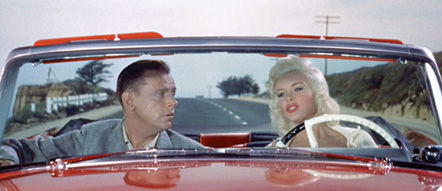 Ewell and Mansfield sit in a car with cheesy rear-screen projection behind them.
Ewell and Mansfield sit in a car with cheesy rear-screen projection behind them.
While an order-bellowing, cigar-chomping Fats keeps tabs on them via telephone, Tom continues to work on Jerri's singing career. In a scene where the couple drive up the coastline in a shiny red convertible, it becomes clear they're falling in love. Waters, however, only has eyes for the bad rear-screen projection of the highway, ocean and telephone poles. "I love that you can tell they're just sitting in a half-car with a movie playing behind them! I love how that looks! Hitchcock did it really badly and used it a lot. Family Plot has the worst rear-screen projection I've ever seen. I think a car rig is so much easier, but maybe they didn't have that back in the '40s and '50s. Or maybe they didn't think of doing it that way. Maybe movie stars weren't about to go out and drive with real wind in their hair. Maybe they wanted controlled wind."
At this point in the movie, Waters has come up with a theory about the talent who perform throughout the film—an impressive roster of over 14 acts including Fats Domino, Gene Vincent, Eddie Cochran and The Platters—and their peculiarly stiff body language. "My guess is that they probably couldn't hit their marks because they'd never done it before. Under those feet are big X's made with gaffer's tape and they told them, 'Don't leave your mark.' What else could it be? They seem glued to the floor," says Waters, also pointing out that part of the movie's richly glamorous look is that the cinematographer Leon Shamroy gives everyone the full-on star treatment. "This movie is an odd mixture: It's real, raw rock 'n' roll put in the completely alien atmosphere of a Hollywood movie. The other rock 'n' roll movies were black and white, really low budget, just total exploitation movies. But this? They're lit like the hugest musical acts."
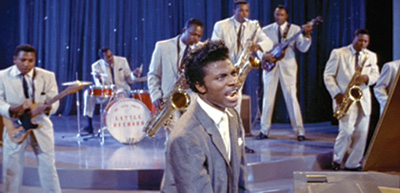 STAR POWER: Little Richard performs "Ready Teddy." The film features raw
STAR POWER: Little Richard performs "Ready Teddy." The film features raw
rock 'n' roll but is shot like a Hollywood movie.
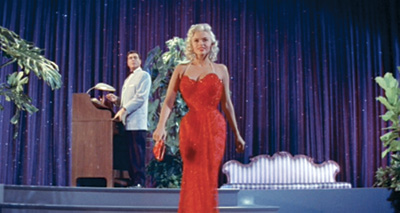
"Look at her," says Waters of Mansfield strutting her stuff, "did she ever look better?
When she's onscreen, who looks at anyone else?"
One of the gentle potshots that Tashlin takes at the music industry is that in accordance with Fats' wishes, Jerri records a song backed by a full orchestra and it's a hit—although her only contribution is a high-pitched elongated squeal because she's supposedly tone deaf. But backstage on the night of her first live rock 'n' roll show, Jerri and Tom kiss for the first time. Then the big reveal: Jerri goes onstage and in a pitch-perfect voice, sings a sad love song to Tom. "I wonder if that's really her," muses Waters. "It doesn't sound like her. You know, on Cry-Baby, we had a lip synch expert. That was his job. Universal wanted me to have him. I thought, 'How long has that job been in existence? Did he go to school to learn how to teach lip-synching?' But it turned out he was good."
Before the movie builds to its climax, the tone turns Keystone Cops as Tom and Fats unite and beat back a gang of rival gangsters. Next, Fats replaces Jerri onstage and begins singing to a swaying, enraptured teenage audience. The camera cuts to the feet of two lovers in a romantic bedroom hideaway and as it pans up, the happy ending: You see that Jerri has left Fats and is with Tom. "It didn't disappoint me one bit," says Waters, as he turns off the DVD player. "Whatever language you're talking in—if it's French, it's homage, if it's English, you just copied—but it just makes me realize how much this movie influenced me." To this day, Waters can't get over how he can watch the film for the trillionth time and still feel such a deep connection. "I don't know if [Tashlin] understood the music. But he worshipped Jayne Mansfield in this movie and always tried to make her look as good as he possibly could," says Waters with real emotion in his voice. "He loved her—and you can feel that, you can feel how he shot her. So what this movie is about is the chemistry between a director and a glamour girl. That was always incredibly important to me. I'm not comparing myself, I'm saying we parodied this and I only parody the things I love."